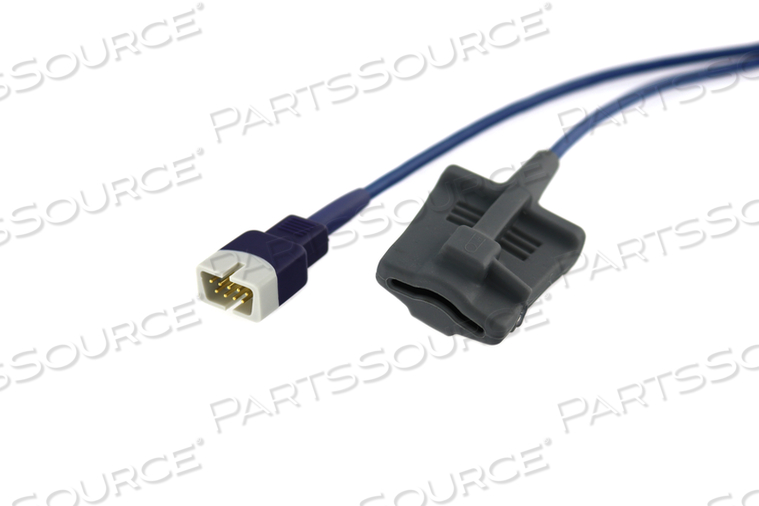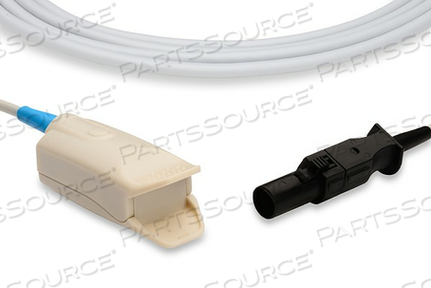SpO2 Cables and Sensors: Understanding Their Role in Pulse Oximetry
The Essential Components of Pulse Oximetry and How They Work
Introduction
Section 1: What Is Pulse Oximetry?
Definition and Explanation of Pulse Oximetry
Benefits and Applications of Pulse Oximetry
How Pulse Oximetry Works
Section 2: Understanding Oxygen Saturation and Its Importance
What is oxygen saturation (SpO2)?
Why is oxygen saturation important?
Section 3: Limitations and Factors Affecting Pulse Oximetry Accuracy
Section 4: Selecting and Using a Pulse Oximeter
Choosing the Right Pulse Oximeter
Section 5: The Future of Pulse Oximetry and Oxygen Monitoring
The Critical Role of Pulse Oximetry in Modern Healthcare
Pulse Oximetry is a non-invasive medical tool used by healthcare professionals to measure the level of oxygen saturation in a patient's blood. It provides instantaneous and accurate results, allowing for timely interventions and treatment adjustments, and can be used in critical care settings or during surgery. Pulse oximetry works on the principle of spectrophotometry, with a pulse oximeter probe emitting light at two different wavelengths (red and infrared) that pass through the skin and are absorbed by the blood. Oxygen saturation, also known as SpO2, is a measure of the percentage of hemoglobin molecules in the blood that are carrying oxygen and is an essential indicator of respiratory function and overall health. The most important details regarding oxygen saturation, pulse oximetry, and pulse oximeter are that oxygen saturation is essential for the body's cells, tissues, and organs to function effectively, and inadequate oxygen levels can lead to cellular damage, organ dysfunction, and even death.

To ensure accurate readings, healthcare professionals must take into account factors such as ambient light, patient movement, and bad placement of sensors. To select the right Pulse oximeter, it is important to consider accuracy, display, and battery life. Additionally, look for a device with a clear and easy-to-read display that shows SpO2, pulse rate, and a plethysmograph. Pulse oximetry is an important part of modern healthcare as it can measure oxygen saturation levels quickly, accurately, and without hurting patients. To ensure accurate readings, the proper use of a Pulse Oximeter should be done to ensure the patient's finger, earlobe, or toe is clean and free of any nail polish or artificial nails.
The probe should be placed on the appropriate site and allow it to stabilize and display a reading. Future developments include wearable devices such as smartwatches and wireless connectivity to remotely monitor patients' oxygen levels and provide real-time feedback. Pulse oximetry is an important part of providing excellent care and treatment for patients, from emergency care and surgery to home monitoring and long-term care for chronic lung conditions. It is important for both doctors and patients to understand how it works and how it should be used, in order to make the most of the technology's accuracy. With ongoing research and technological improvements, pulse oximetry is likely to play a bigger role in preventing, finding, and treating respiratory and other health problems.
Section 1: What Is Pulse Oximetry?
Definition and Explanation of Pulse Oximetry
Pulse oximetry is a non-invasive and essential medical tool used by healthcare professionals to measure the level of oxygen saturation in a patient's blood. This simple, painless procedure provides critical information about the patient's respiratory function and overall health and can indicate the need for supplemental oxygen or other medical interventions.
Benefits and Applications of Pulse Oximetry
Pulse oximetry offers numerous benefits and has a wide range of applications in various medical settings, including:
-
Rapid assessment: pulse oximetry provides instantaneous and accurate results, allowing for timely interventions and treatment adjustments.
-
Non-invasive: This method is painless and does not require any blood samples, making it a comfortable option for patients, especially children and those with needle phobias.
-
Continuous monitoring: In critical care settings or during surgery, pulse oximetry allows for real-time monitoring of a patient's oxygen saturation levels, alerting healthcare professionals to any sudden changes or potential issues.
-
Home monitoring: Pulse oximeters can be used at home for patients with chronic lung diseases or sleep apnea, enabling them to monitor their oxygen levels and adjust therapy as needed.
-
Emergency care: In emergency situations, pulse oximetry can quickly identify patients with respiratory distress or hypoxia, aiding in triage and prioritization.
Pulse oximetry operates on the principle of spectrophotometry. A pulse oximeter probe, usually placed on a patient's fingertip, earlobe, or toe, emits light at two different wavelengths (red and infrared) that pass through the skin and are absorbed by the blood. The device then measures the amount of light absorbed and calculates the patient's oxygen saturation based on the differences in absorption between oxygen-rich (oxyhemoglobin) and oxygen-poor (deoxyhemoglobin) blood.
Section 2: Understanding Oxygen Saturation and Its Importance
What is oxygen saturation (SpO2)?
Oxygen saturation, also known as SpO2, is a measure of the percentage of hemoglobin molecules in the blood that are carrying oxygen. It is an essential indicator of respiratory function and overall health, with normal SpO2 levels ranging from 95% to 100%. When oxygen saturation levels fall below the normal range, it can be a sign of respiratory distress or other medical conditions that require immediate attention.
Why is oxygen saturation important?
Maintaining proper oxygen saturation is crucial for the body's cells, tissues, and organs to function effectively. Inadequate oxygen levels can result in cellular damage, organ dysfunction, and, in severe cases, death. Monitoring oxygen saturation through pulse oximetry helps healthcare professionals detect and address potential issues before they become life-threatening.

Section 3: Limitations and Factors Affecting Pulse Oximetry Accuracy
The accuracy of SpO2 cables and sensors can be affected by things like ambient light, patient movement, and bad placement of the sensors.
-
Poor perfusion: Low blood flow to the area where the probe is placed can result in inaccurate readings. This can be caused by hypothermia, vasoconstriction, or low blood pressure.
-
Motion artifacts: Patient movement or tremors can interfere with the probe's ability to obtain accurate readings.
-
Ambient light: Bright light sources can interfere with the light emitted by the pulse oximeter, leading to inaccurate results.
-
Dark nail polish or artificial nails: These can absorb the light emitted by the pulse oximeter, making it difficult for the device to accurately measure oxygen saturation levels.
-
To get accurate readings and extend the life of SpO2 cables and sensors, they must be properly cared for. hemoglobin molecules that may affect the accuracy of pulse oximetry readings
-
Skin pigmentation: In some cases, high levels of skin pigmentation can interfere with the light absorption measurements taken by the pulse oximeter, leading to less accurate readings.
Despite these limitations, pulse oximetry remains a critical tool for assessing and monitoring patients' oxygen saturation levels. By understanding these factors and taking them into account, healthcare professionals can ensure they are using pulse oximetry effectively to provide the best possible care.
Section 4: Selecting and Using a Pulse Oximeter
Choosing the Right Pulse Oximeter
When selecting a pulse oximeter, it is essential to consider the following factors:
-
Accuracy: Look for a pulse oximeter with an accuracy of 2% or better to ensure reliable oxygen saturation readings.
-
Display: Choose a device with a clear and easy-to-read display that shows SpO2, pulse rate, and a plethysmograph (a waveform representation of blood flow).
-
Battery life: Opt for a pulse oximeter with a long battery life to minimize the need for frequent battery replacement or recharging.
-
Size and portability: Consider the size and portability of the device, especially if it will be used in a home or mobile setting.
-
Alarm features: Some pulse oximeters come with adjustable alarms that can alert users to low oxygen saturation levels or abnormal pulse rates.
Section 5: The Future of Pulse Oximetry and Oxygen Monitoring
As technology continues to advance, the future of pulse oximetry and oxygen monitoring looks promising. Researchers are looking into new ways and technologies that could make pulse oximetry more accurate and useful. Some potential developments include:
-
Wearable devices: Incorporating pulse oximetry technology into wearable devices, such as smartwatches, could allow for continuous, non-invasive monitoring of oxygen saturation levels and early detection of potential health issues.
-
Wireless connectivity: Integration of wireless connectivity into pulse oximeters could enable healthcare professionals to remotely monitor patients' oxygen levels and provide real-time feedback.
-
Enhanced accuracy: Ongoing research aims to improve the accuracy of pulse oximetry readings, even in situations with poor perfusion or other factors that currently limit the technology.

The Critical Role of Pulse Oximetry in Modern Healthcare
Pulse oximetry has become an important part of modern healthcare because it can measure how much oxygen is in a patient's blood quickly, accurately, and without hurting them. Pulse oximetry has been shown to be an important part of making sure that patients get the best care and treatment, from emergency care and surgery to home monitoring and long-term care for chronic lung conditions.
As we've seen in this article, it's important for both doctors and patients to understand how pulse oximetry works, what it can and can't do, and how it should be used. By learning about what affects the accuracy of pulse oximetry and choosing the right device, users can make sure they get the most out of this useful technology.
Pulse oximetry has a bright future, thanks to ongoing research and technological improvements that are paving the way for more accurate devices that can be worn and remote monitoring. As these new ideas continue to develop, pulse oximetry is likely to play an even bigger role in preventing, finding, and treating respiratory and other health problems
